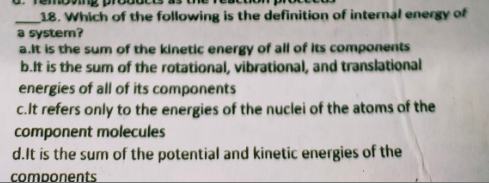e sum of the rotational, vibrational, and translational of all of its components s only to the energies of the nuclei of the atoms of t ent molecules sum of the potential and kinetic energies of the nts
e sum of the rotational, vibrational, and translational of all of its components s only to the energies of the nuclei of the atoms of t ent molecules sum of the potential and kinetic energies of the nts
Physical Chemistry
2nd Edition
ISBN:9781133958437
Author:Ball, David W. (david Warren), BAER, Tomas
Publisher:Ball, David W. (david Warren), BAER, Tomas
Chapter17: Statistical Thermodynamics: Introduction
Section: Chapter Questions
Problem 17.17E
Related questions
Question

Transcribed Image Text:18. Which of the following is the definition of internal energy of
a system?
a.it is the sum of the kinetic energy of all of its components
b.it is the sum of the rotational, vibrational, and translational
energies of all of its components
c.lt refers only to the energies of the nuclei of the atoms of the
component molecules
d.It is the sum of the potential and kinetic energies of the
components
Expert Solution
This question has been solved!
Explore an expertly crafted, step-by-step solution for a thorough understanding of key concepts.
Step by step
Solved in 2 steps

Knowledge Booster
Learn more about
Need a deep-dive on the concept behind this application? Look no further. Learn more about this topic, chemistry and related others by exploring similar questions and additional content below.Recommended textbooks for you

Physical Chemistry
Chemistry
ISBN:
9781133958437
Author:
Ball, David W. (david Warren), BAER, Tomas
Publisher:
Wadsworth Cengage Learning,

Physical Chemistry
Chemistry
ISBN:
9781133958437
Author:
Ball, David W. (david Warren), BAER, Tomas
Publisher:
Wadsworth Cengage Learning,